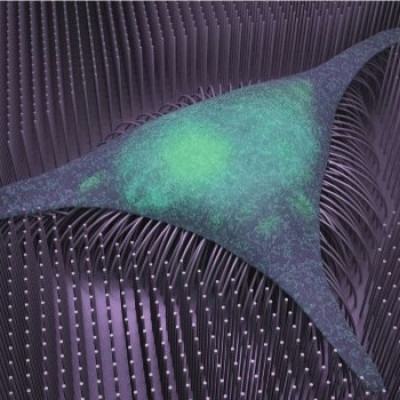
2022-07-11
Visited : 1238
Nanotechnology that accelerates the transition of stem cells into bone could advance regenerative medicine.
A nanotechnology platform developed by KAUST scientists could lead to new treatments for degenerative bone diseases.
The system takes advantage of tiny iron wires that bend in response to magnetic fields. Bone-forming stem cells grown on a mesh of these nanowires get a kind of physical workout on the moving substrate. They then transform into mature bone much faster than is typical of other culturing conditions, with a differentiation protocol that lasts just a few days instead of a few weeks.
“This is a remarkable finding,” says bioscientist Jasmeen Merzaban. “We can achieve efficient bone cell formation in a shorter amount of time,” potentially paving the way for more efficient regeneration of bone. Merzaban co-led the study together with sensor scientist Jürgen Kosel and colleagues from their labs.
The researchers evaluated the bone-producing potential of their nanowire scaffold, both with and without magnetic signals. They patterned the tiny wires — each about the size of the tail-like appendage found on some bacteria — in an evenly spaced grid and then layered bone marrow–derived human mesenchymal stem cells (MSCs) on top.
Adding a low-frequency magnetic field, the researchers found, dramatically accelerated the process of bone development. Genetic markers of bone development could be detected within two days of incubation under mechanical stimulation, while genes linked to stemness and self-renewal quickly became inactive. Under a microscope, the researchers could also see the cells remodeling themselves to become more bone-like at an accelerated pace.
The KAUST team next plans to test its system in mouse models of degenerative bone disease, with the expectation that stem cell–seeded nanowire scaffolds can be safely implanted at sites of injury and promote tissue repair. An externally applied magnetic field would be used to speed the healing process.
Study author Jose Efrain Perez, a former Ph.D. student in Kosel’s lab, also sees potential applications in other disease settings. As he points out: “Varying the matrix stiffness by increasing or decreasing nanowire length and diameter could promote differential responses with MSCs.” Or they could use other types of stem cells to, for example, promote neuronal growth and brain repair after a stroke.
What’s more, Perez adds, “We could further customize the nanowire scaffold itself or the base material — for instance, by using different metals to exploit their magnetic responses or coating the nanowires with biomolecules for potential delivery upon cellular contact.”
For such a small technology, the possibilities are huge.
Read the original article on King Abdullah University of Science and Technology (KAUST).